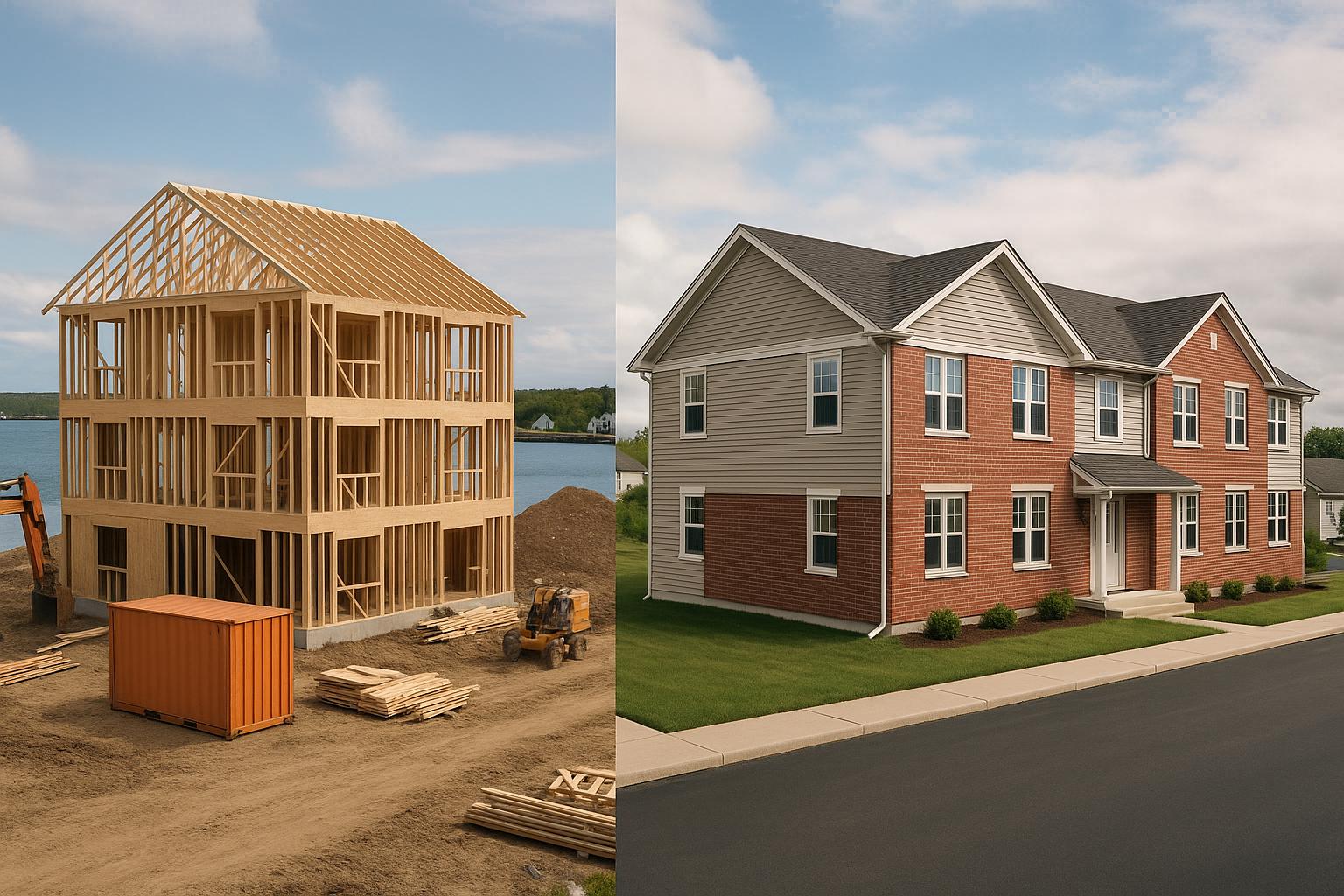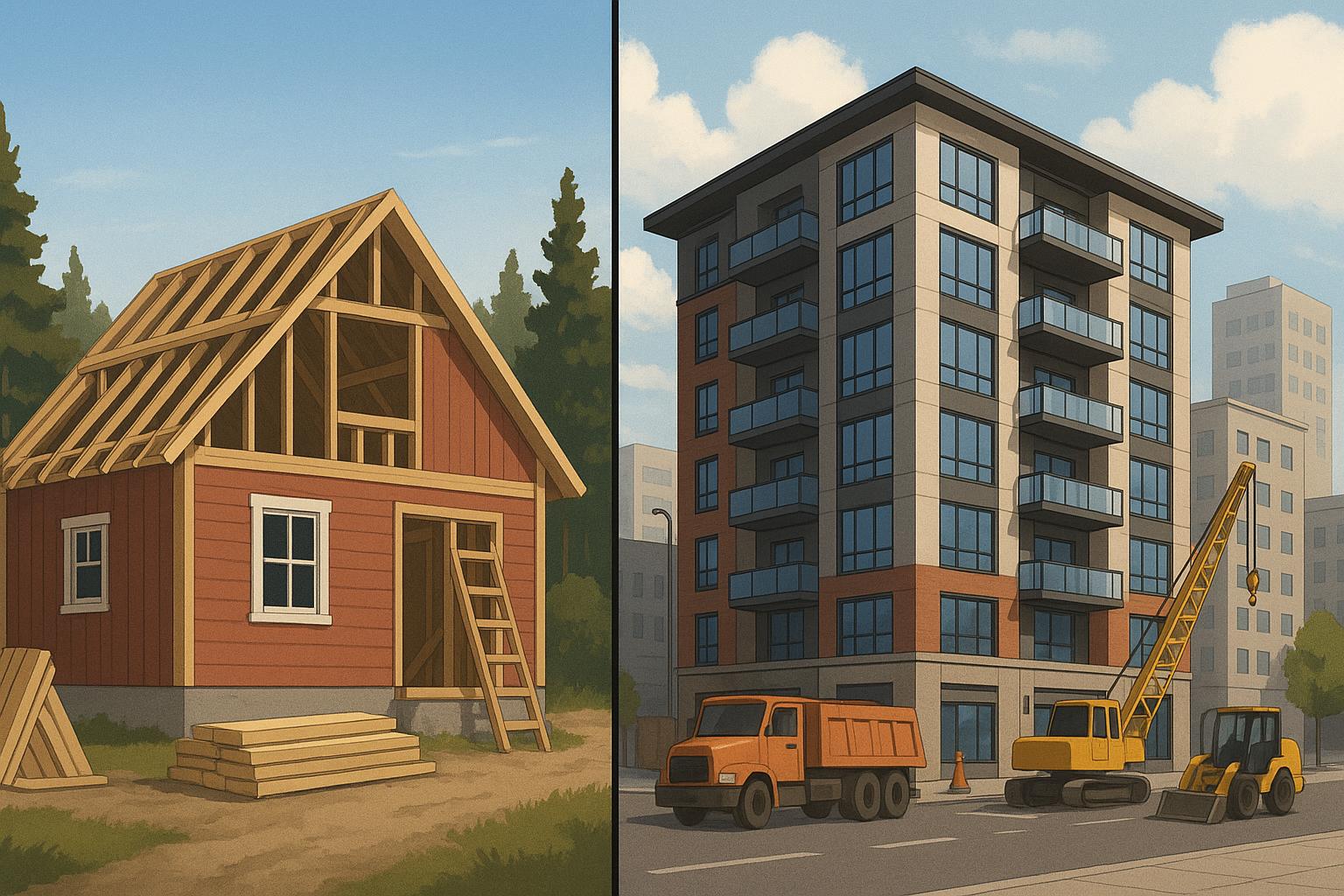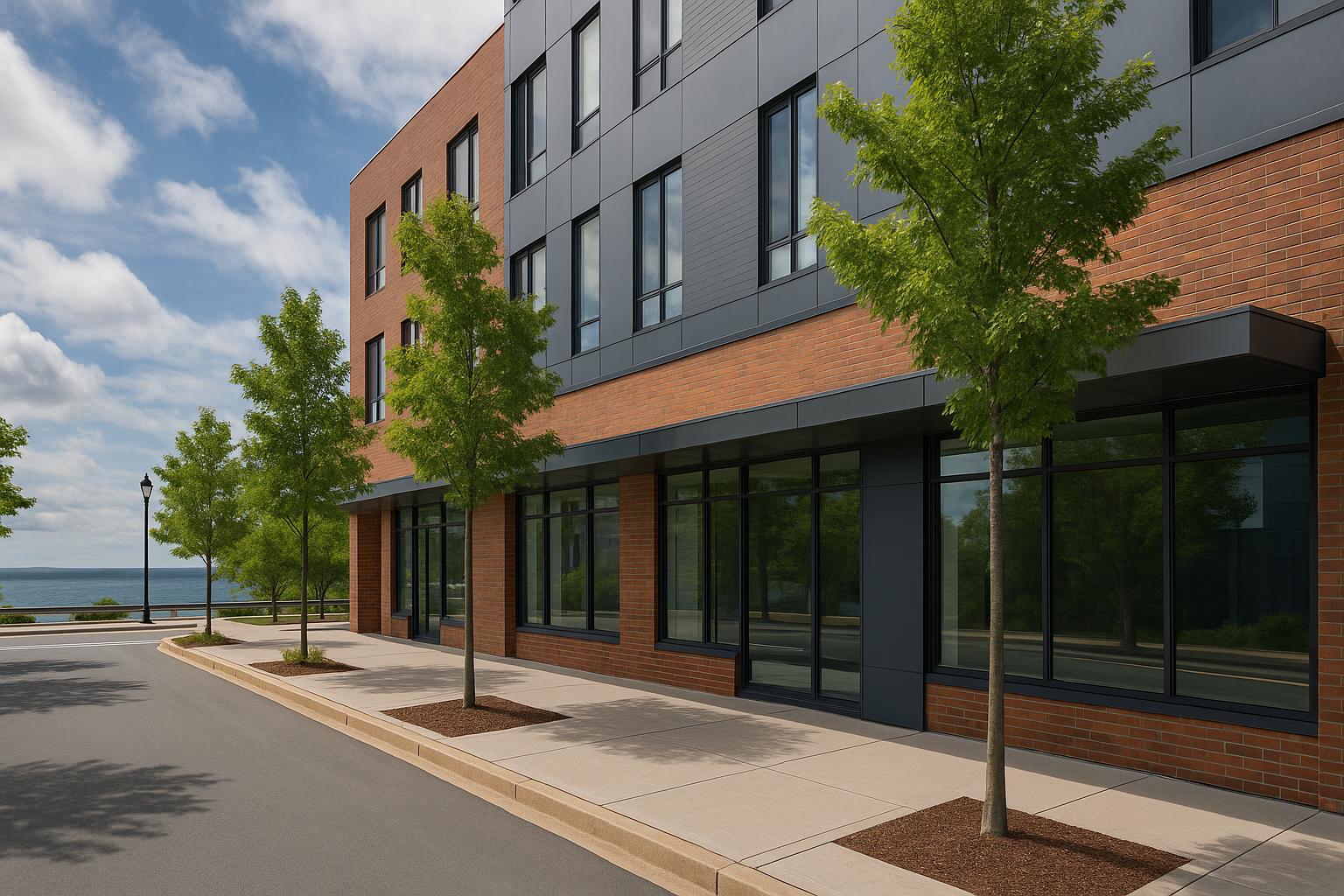Halifax's ER-3 zoning is transforming property values. By allowing up to eight residential units per lot, this new classification under the Centre Plan opens doors to higher-density housing. Property owners in walkable areas with transit and amenities can now generate more rental income and see increased land value. With reduced parking requirements and simplified permitting, ER-3 zoning makes multi-unit construction more feasible and profitable.
Key Takeaways:
- What is ER-3 Zoning? Allows up to 8 units per lot, reducing parking to 1 space per 3 units.
- Why it Matters: Halifax's rental market has a 1.0% vacancy rate, and rents are up 11% annually, making multi-unit properties lucrative.
- Financial Gains: Annual rental income for an 8-unit property can reach $187,200, with ROI between 12-20%.
- Construction Costs: A 4-unit building averages $640,000; an 8-unit one costs around $1,280,000.
ER-3 zoning is a game-changer for Halifax property owners, offering a clear path to maximize rental income and property value. However, understanding zoning rules, securing permits, and using efficient construction methods is critical to success.
Benefits of ER-3 Zoning for Property Owners
More Units and Increased Land Value
ER-3 zoning allows property owners to build up to eight residential units on a single lot, compared to the single-family zoning that permits just one unit. This shift significantly boosts the land's potential, as it can now support multiple income-generating units.
Another advantage is the reduced parking requirements under ER-3 zoning. Only one parking space is required for every three units, freeing up more space for additional living units rather than parking infrastructure. This maximization of buildable space not only increases the property's value but also enhances its rental income potential.
Higher Rental Income and Better ROI
With the ability to construct multiple units, property owners can dramatically increase their rental income. Instead of earning rent from one single-family home, they can collect revenue from up to eight units on the same lot. Given Halifax's rental market, where average rents for quality two-bedroom units range from $1,950 to $2,100 per month, the income potential is substantial.
Properties with four or more units often yield annual returns of 12-20%. This higher return on investment comes not just from increased rental income but also from economies of scale, which reduce per-unit costs for maintenance, property management, and utilities.
Comparing ER-1, ER-2, and ER-3 Zoning
Here's how ER-3 zoning stacks up against other zoning types:
| Zoning Type | Maximum Units | Typical Building Types | Parking Requirements | Development Potential |
|---|---|---|---|---|
| ER-1 | 1-2 units | Single-family homes, duplexes | 1 space per unit | Limited density |
| ER-2 | Up to 4 units | Townhouses, small apartment buildings | 1 space per unit | Moderate density |
| ER-3 | Up to 8 units | Multi-unit residential buildings | 1 space per 3 units | High density |
As the table shows, ER-3 zoning offers a significant advantage by accommodating up to four times more units than ER-1 zoning, while also requiring fewer parking spaces per unit. This combination of higher density and reduced parking demands makes ER-3 zoning a standout option for property owners aiming to maximize their land's potential.
Additionally, ER-3 zoning provides greater design flexibility, allowing property owners to explore various layouts for their units. From traditional apartment-style designs to more creative multi-unit configurations, this flexibility can help command premium rents in Halifax's competitive rental market.
Halifax Wants URGENT CHANGES to Planning Rules for Housing
Economic Impact of ER-3 Zoning
The advantages of ER-3 zoning go beyond design and income potential - it also delivers a notable economic boost.
New Construction and Economic Growth
ER-3 zoning has spurred a surge in construction activity across Halifax. Homeowners who previously hesitated to invest in major renovations or rebuilds on single-family lots now find it financially worthwhile to embark on new construction projects.
This increased activity benefits a wide range of professionals, from contractors to material suppliers, as multi-unit developments demand far more resources than single-family home renovations. Many property owners are opting for integrated design-build firms to manage their ER-3 projects. This approach eliminates the hassle of juggling multiple contractors, which often leads to budget overruns of 30–60% and project delays that stretch timelines from 8 months to over 18 months. By consolidating all services under one roof, these firms deliver projects more efficiently. For example, a four-unit ER-3 building typically costs around $640,000, while an eight-unit project averages $1,280,000.
Property Values and Rental Rates
Rezoning to ER-3 often results in an immediate increase in property value due to the expanded development potential. Land that was once confined to single-family use now carries a premium, thanks to the ability to build multi-unit properties.
The rental market also reaps rewards. Halifax continues to face a shortage of rental housing, and new multi-unit developments are highly sought after. Modern two-bedroom units, for instance, command monthly rents between $1,950 and $2,100. These premium rates reflect both the scarcity of updated rental options and the appeal of energy-efficient features like ductless heat pumps, triple-pane windows, and advanced insulation. This zoning flexibility allows property owners to maximize their buildable space, further boosting rental income potential.
Financial Scenarios for Property Owners
The shift from single-family homes to multi-unit rentals under ER-3 zoning translates into substantial financial gains. Below is a comparison of potential returns:
| Scenario | Single-Family Rental | 4-Unit ER-3 Building | 8-Unit ER-3 Building |
|---|---|---|---|
| Monthly Rental Income | $1,800 | $7,800 | $15,600 |
| Annual Rental Income | $21,600 | $93,600 | $187,200 |
| Construction Investment | $50,000 (renovation) | $640,000 | $1,280,000 |
| Annual ROI | 8–10% | 12–15% | 15–20% |
| Parking Spaces Required | 1–2 spaces | 2 spaces | 3 spaces |
With financing options like CMHC MLI Select, offering up to $200,000 per unit and up to 95% financing, property owners can see positive cash flow from the outset. Fixed-price contracts and six-month project timelines ensure quicker completion, reducing financing costs that typically range from 6–8% annually during construction. Delays not only defer rental income but also increase carrying costs, making streamlined projects under ER-3 zoning an attractive option for investors.
How to Maximize Value Under ER-3 Zoning
To make the most of ER-3 zoning, property owners need to follow a clear process, adopt a streamlined construction approach, and steer clear of common multi-unit project pitfalls. Here’s how to do it.
Steps to Use ER-3 Zoning
Turning a single-family property into a profitable multi-unit rental starts with a thorough site assessment. First, confirm your lot's ER-3 zoning by consulting the Halifax zoning map. Keep in mind that heritage districts may impose restrictions on density.
Once you’ve verified the zoning, the next step is to figure out the best unit configuration. This depends on your lot size and municipal setback requirements. Many ER-3 properties begin with at least four units, though additional units might be possible depending on the specifics of your site. Securing financing early is also critical - lenders will want to see detailed plans and cost estimates before moving forward.
During the design phase, collaboration is key. Architects, engineers, and municipal planners need to work together to ensure the project meets building codes while maximizing rental income potential. An integrated approach can simplify this phase, reducing delays and uncertainties. Timely completion is crucial because delays can lead to higher carrying costs and lost rental income.
This is where an integrated design-build model can make all the difference.
Benefits of Integrated Design-Build
Once you’ve mapped out the steps, an integrated design-build approach can help minimize risks. The traditional model of juggling multiple contracts is quickly becoming outdated. Companies like Helio Urban Development offer a one-stop solution, handling everything from design to construction.
With this model, you work with one firm that manages the entire process. This eliminates the headaches of coordinating multiple contractors and reduces the chance of miscommunication. Lloyd Liu, CEO of Helio Urban Development, highlights how this approach ensures timelines are met, drawing on his own experience with delays in traditional projects.
Financially, the benefits are hard to ignore. Integrated firms often provide fixed-price contracts, such as $160,000 per unit or $200,000 per unit under CMHC MLI Select. These prices include high-quality finishes like quartz countertops, engineered hardwood flooring, and triple-pane windows - features that attract higher rental rates.
Helio also backs its work with a six-month construction guarantee, offering penalties of up to $1,000 per day for delays. This level of confidence comes from having full control over every detail, from ordering materials to scheduling trades.
Avoiding Construction Problems
The integrated design-build method tackles common construction challenges head-on:
| Construction Challenge | Traditional Fragmented Approach | Integrated Design-Build Solution |
|---|---|---|
| Budget Control | Cost overruns are frequent | Fixed-price contracts with no surprises |
| Timeline Management | Delays stretch projects to 12–18 months | Guaranteed 6-month completion |
| Quality Assurance | Multiple warranties across trades | Single 2-year warranty for everything |
| Project Communication | Many contractors, scattered updates | Daily photo updates from one team |
| Problem Resolution | Contractors blame each other | One team takes full accountability |
This approach doesn’t just save money - it can cut out around $47,000 per project by avoiding duplicate site visits, conflicting schedules, and rework. Quality is another big win. Systematic inspections, including five checks by professional engineers, ensure high standards. Plus, property owners get the final say by choosing the last inspector.
Daily photo updates keep you informed on progress, allowing for quick issue resolution and helping the project stay on track.
For property owners ready to dive into ER-3 construction, the integrated design-build model offers a reliable way to achieve 12–20% annual returns. With fixed costs, guaranteed timelines, and single-point accountability, this method removes much of the uncertainty that can come with multi-unit projects.
sbb-itb-16b8a48
ER-3 Zoning Rules and Limits
ER-3 zoning offers exciting possibilities for property development, but it also comes with specific rules that need to be addressed early in the planning process. Being aware of these regulations can help you avoid unnecessary delays and unexpected expenses.
Building Code Requirements
If you're planning a project in an ER-3 zone, you'll need to follow the Halifax Regional Municipality (HRM) Centre Plan Land Use By-law. This by-law sets out the construction and design standards you must meet. For new developments, you'll require both a development permit and a construction permit. Many as-of-right projects benefit from a streamlined permitting process, but if your project doesn't fully align with the by-law, you'll need site plan approval.
Key limitations include restrictions on building height, width, setbacks, and overall design. For ER-3 zones that are next to Established Residential areas, specific transition rules apply. These may require larger setbacks or landscaped buffers to ease the shift between zones. On the plus side, many parking minimums have been removed, and design guidelines are now part of the by-law itself [1]. Knowing these requirements in advance will help you navigate the process more smoothly and stay aligned with HRM's evolving standards.
Staying Updated on Municipal Changes
Municipal regulations are always changing, and the Centre Plan has replaced older frameworks while consolidating development guidelines. If you’ve already received construction permits, started work within a year, and plan to complete your project before updated by-laws take effect, your existing development rights are protected. For non-conforming structures, extensions, enlargements, or alterations are allowed, provided they don’t increase the level of non-compliance.
For detailed information specific to your project, it's a good idea to review the full Land Use By-law and reach out to HRM Planning & Development [1].
Working with an integrated design-build provider can also make the process easier. These providers handle everything from permit applications to ensuring compliance with zoning rules, so you won't need to coordinate with multiple municipal departments. This approach simplifies technical aspects like setback calculations, transition requirements, and adherence to design standards, saving you time and hassle.
Conclusion: Using ER-3 Zoning Value in Halifax
Key Points
The introduction of ER-3 zoning in Halifax has opened up new opportunities for property owners, offering a pathway to significantly enhance property value and rental income. With the ability to build higher-density multi-unit rental properties, such as fourplexes and larger buildings, property owners can transform single-family home lots into income-generating assets. This shift not only boosts property value but also strengthens rental income streams, making it a game-changer for investors.
The financial upside is clear: higher rental income, improved cash flow, and the chance to tap into Halifax's surging rental demand. Property owners who take advantage of ER-3 zoning can see annual returns ranging from 12% to 20%, a substantial improvement compared to single-family rental investments.
However, success hinges on understanding the rules. The Centre Plan Land Use By-law outlines the requirements, and many projects benefit from simplified permitting processes. That said, staying compliant with building codes, setback rules, and design standards is critical to avoid costly delays and surprises.
Next Steps for Property Owners
If you own property in an ER-3 zone, now is the time to act. Start by evaluating your land’s potential for development. Check for any specific requirements in your area, such as heritage district exemptions or transition rules that might impact your plans. Reach out to HRM Planning & Development to get a clear picture of the permit process and timelines for your project.
To make the most of this opportunity, consider partnering with professionals who are well-versed in both regulatory guidelines and the complexities of multi-unit construction. Relying on multiple contractors can lead to unexpected costs and delays, so it may be worth exploring integrated design-build providers. These firms offer fixed-price contracts and promise streamlined timelines, often completing projects in as little as six months. They handle everything - from permits to final construction - under one roof, saving you time and reducing stress.
ER-3 zoning has unlocked real potential in your property, but turning that potential into profit requires a thoughtful approach. By understanding your options and collaborating with experienced professionals, you can navigate the entire process smoothly - from securing permits to collecting rental income.
FAQs
How does Halifax's ER-3 zoning increase property values and rental income potential?
ER-3 Zoning in Halifax: A Game Changer for Property Owners
Halifax's ER-3 zoning opens up exciting possibilities for property owners by permitting up to eight units per lot. This zoning shift isn't just about increasing density - it's a chance to create multi-unit rental properties that can significantly enhance income potential and boost return on investment (ROI).
With Halifax's rental demand on the rise, ER-3 zoning allows for smarter land use. By developing multi-unit properties, you can not only tap into this growing market but also turn your property into a high-performing investment. Plus, you'll be contributing to the city's pressing need for more housing options, making it a win-win for everyone involved.
How can Halifax property owners convert single-family homes into multi-unit buildings under ER-3 zoning?
Transforming Single-Family Homes Under Halifax's ER-3 Zoning
Halifax's ER-3 zoning opens up exciting opportunities for property owners by allowing single-family homes to be converted into multi-unit buildings - potentially up to 8 units per lot. But before diving in, it's crucial to familiarize yourself with the ER-3 zoning regulations. These rules cover essential details like maximum building sizes and design requirements, ensuring your project stays within legal boundaries.
Once you're clear on the guidelines, the next steps include drafting detailed plans, obtaining the necessary permits, and exploring financing options for the conversion. Bringing in professionals who specialize in multi-unit construction can make the process much smoother, offering valuable insights and avoiding costly mistakes.
With rental demand on the rise in Halifax, converting your property under ER-3 zoning could lead to increased rental income and solid long-term returns. It's an opportunity not just to meet housing needs but also to enhance the value of your investment.
What are the benefits of choosing an integrated design-build approach for ER-3 zoning projects in Halifax?
An integrated design-build approach streamlines the process of developing ER-3 properties by merging the design and construction phases into one cohesive workflow. This setup fosters better communication between all parties involved, helping to avoid delays and keeping projects on track.
For property owners, this method offers more predictable costs and clear accountability, as a single team oversees everything from start to finish. This minimizes unexpected expenses and creates a smoother overall experience. Plus, the design-build model allows for flexible, creative solutions that make the most of ER-3 zoning. For instance, layouts can be optimized to boost rental income and improve return on investment (ROI).
In short, this approach offers a quicker, more efficient, and cost-conscious way to transform properties to meet Halifax’s growing need for rental housing.



